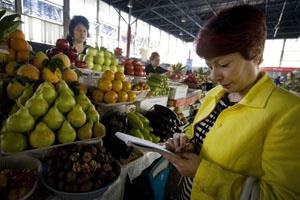
18 April 2012, Baku, Azerbaijan - By 2030 undernourishment will be only a minor problem in Europe and Central Asia, but obesity and diet-related illnesses like heart disease could emerge as major challenges for public policy, FAO said today.
Hunger currently affects less than five percent of the population in most of the region but remains a significant concern in large parts of the Caucasus and Central Asia, according to a report to be presented at the start of the Organization's biennial Regional Conference for Europe and Central Asia. However, the percent of people experiencing hunger in the Caucasus and Central Asia will drop from nine to two percent by 2030 and then to one percent by 2050, the report predicts.
The report goes on to warn that as diets shift from cereals towards higher consumption of meat and dairy the risk factors behind chronic, non-communicable diseases could rise in parts of the region. Besides diet, lifestyle habits, poverty and medical care also influence obesity, disease and death rates, the report adds.
These increased risk levels will place greater pressure on healthcare facilities in the poorer countries of Central Asia than in the EU.
Closing the "yield gap"
In rural areas of Eastern Europe, the Caucasus and Central Asia, crop production by small farmers - especially for cereal - falls well below potential yields, sometimes to as low as 30-40 percent of potential. Boosting production would not only address food security needs but also combat rural poverty by raising farmers' incomes. The conference will discuss what agricultural policies can turn the situation around.
Reducing environmental impacts
How to improve agriculture's environmental sustainability will also be on the table. In the EU, the use of chemical fertilizers is set to grow by 20 percent by 2050. Meanwhile, agriculture in the Caucasus and Central Asian countries is making intensive use of water resources, often inefficiently. Up to half of irrigation water is lost en route to fields because of dilapidated systems of water delivery, putting enormous stress on water supplies.
Challenges in boosting food production
Annual agriculture production in Europe and Central Asia is expected to be 20 percent higher in 2050 compared to 2005/2007. The bulk of the projected increases will likely come from higher yields, the report notes, not by bringing new land under cultivation.
A business as usual approach to boosting yields would involve higher fertilizer and other chemical input applications. Water for agricultural purposes in the Caucasus and Central Asian countries would likely continue to be exploited at unsustainable levels to support substantial rates of crop growth in the region of 0.81 percent per year. These challenges need to be considered in future government policy, FAO's report says.
FAO's Regional Conference for Europe and Central Asia brings together government ministers and officials from 53 countries and the European Union to discuss policy and trends and decide on the Organization's future work programme in the region.